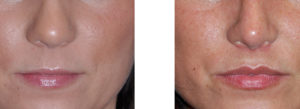Patients desiring changes to the nose and reshaping of the upper lip are common. Nose changes are done by a variety of rhinoplasty techniques and lip changes accomplished by augmentations or surgical lifts. One of these uplifting lip procedures is the well known subnasal lip lift. Because it is done by an excision of tissue along the base of the nose, there has always been concerns about whether it should be performed with an open rhinoplasty or done separately.

In the October 2017 issue of JAMA Facial Plastic Surgery Journal, a Surgical Pearl was published entitled ‘Combining Rhinoplasty with Upper Lip Lift Using a Single Line Incision’. In this paper the author describes his technique for combining two ‘nasal’ operations using a V-shaped incision located in the posterior third of the columella. This incision line then connects with the subnasal incision line. In the nasal sill area the flap extends about 3mms into the nose and then goes along the nasal alar crease laterally. The author describes a subnasal issue resection down to the anterior nasal spine and muscle plication sutures out laterally.
The use of a single base columellar incision location makes sense when the two procedures are combined. This certainly avoids any skin necrosis concerns but also potentially creates traction on nasal tip work due to the downward pull of the elevated upper lift. This would account for support sutures placed through the caudal septum to the central lip segment as well as muscle plication out laterally to prevent downward traction on the nose .
Dr. Barry Eppley
Indianapolis, Indiana


